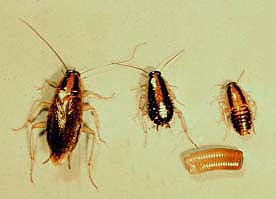
cockroach-pictures.com
Home
Cockroach facts
Cockroach life cycle
Cockroach feeding habits
Cockroach pest control
Cockroach pictures
American cockroach pictures
German cockroach pictures
Oriental cockroach pictures
Cockroach disease
Cockroach myths
Cockroach links
English
Deutsch
Francais
Espaniol
Portuguesa
Visit also:
Termite pictures (everything about termites)
Ant pictures (everything about ants)
Cicada pictures (everything about cicadas)
Mosquito pictures (everything about mosquitos)
(c)2004 cockroach-pictures.com
Cockroach (Feeding) Habits
The cockroaches normally encountered by humans in his dwellings and food establishments are the German cockroach, Blattella germanica (L.), the American cockroach, Periplaneta americana (L.), and the Oriental cockroach, Blatta orientalis (L.). Each of these cockroaches undergoes a life cycle involving an egg capsule, a series of nymphs, and an adult.
With the exception of the female Oriental cockroach, the adults of these three cockroaches have well-developed wings. However, they almost never fly; movement by both the adults and the wingless nymphs is by walking or rapid running. These three cockroaches can be distinguished by color and size. Adult German cockroaches are tan to medium brown in color and fairly small in size (10-15 mm). Adult American cockroaches are reddish brown in color and large in size (35-40 mm). Adult Oriental cockroaches are fairly large in size (26-30 mm) and are shiny, dark brown or black in color.
 Cockroaches require food, water, and places to hide and are, therefore, found in situations where these requirements can be met. They are nocturnal, remaining hidden during the day and becoming active at night to obtain food and water, and to reproduce.
Cockroaches require food, water, and places to hide and are, therefore, found in situations where these requirements can be met. They are nocturnal, remaining hidden during the day and becoming active at night to obtain food and water, and to reproduce.The German cockroach commonly occurs in kitchens; the American cockroach appears more often in food establishments; and the Oriental cockroach is usually associated with dampness around sinks or in basements. Cockroaches are not normally encountered by man unless their populations become very large.
Cockroaches will eat almost anything: left-over human food, wood, leather, cigarette butts, tooth paste, milk, sugary materials, coffee grinds, glue, soap, feces, fabric, shoes, paint, the glue on the back of wallpaper, human hair, fingernails, etc.